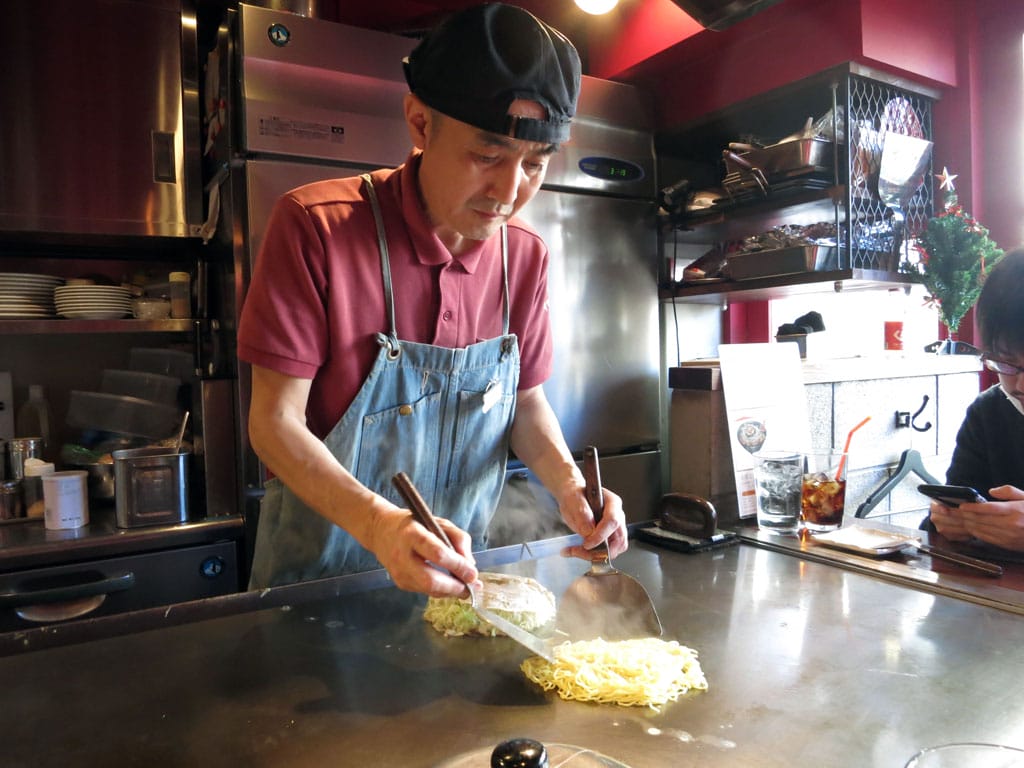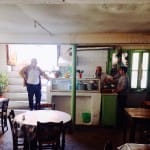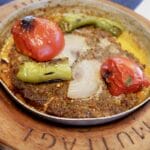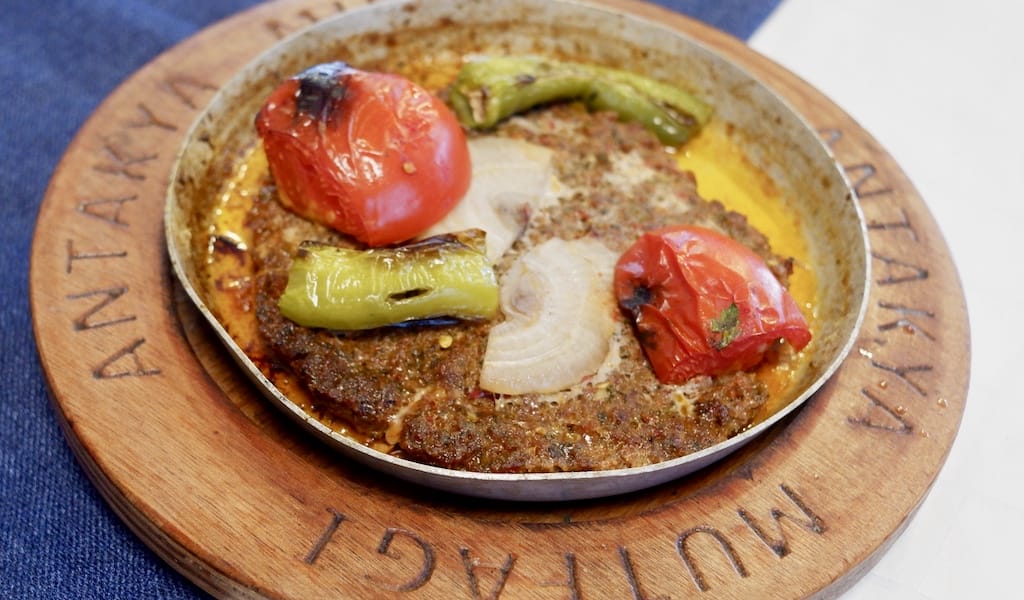What is it that’s so dizzyingly addictive about okonomiyaki? It might be the interactive DIY nature of building your own meal and serving it up from a Japanese teppan grill. Perhaps it’s the communal feeling of sitting around with a beer or two and cooking together. However, most likely is the fact that it’s so darn delicious and satisfying. It’s Japanese soul food that has somehow not quite reached the shores of many foreign countries.
Okonomiyaki is a flavorful pancake chock full of whatever ingredients appeal, cooked on a Japanese grill (okono means “cook whatever you like” and yaki means grill). In all parts of Japan it’s the secret second cousin to ramen in the family of fast food and cheap student eats. It’s a dish that has evolved slowly in Japanese culture as a means of spending time eating inexpensive and nutritious food, especially during times when there wasn’t a great deal of fresh produce or rice available.
The base of this omelet-style pancake is flour, grated nagaimo (yam), eggs, cabbage and a liquid such as water or dashi (kelp and dried bonito stock). The diner usually then includes add-ons such as green onions, meats, fish and vegetables selected from a menu. All of this is presented mixed together and raw to customers, who cook their own pancakes on the grill, tending it slowly over conversation and drink. The final product is topped off with otafuku sauce (similar to Worcestershire sauce), aonori (seaweed flakes), katsuobushi (bonito flakes), Japanese mayonnaise and pickled ginger.
Okonomiyaki most likely originated in Osaka, and the Kansai version is what is most widely eaten in Japan. But at Jyaken Nou, one has the opportunity to experience Hiroshima-style okonomiyaki prepared by a master. The Hiroshima version is noodle based, with a thin layer of batter, and is difficult to cook oneself. That’s where Fuku-san, the owner/chef comes in. Born in Funairi-machi in Naka ward, Hiroshima City, he builds, transforms and sculpts each order to savory perfection.
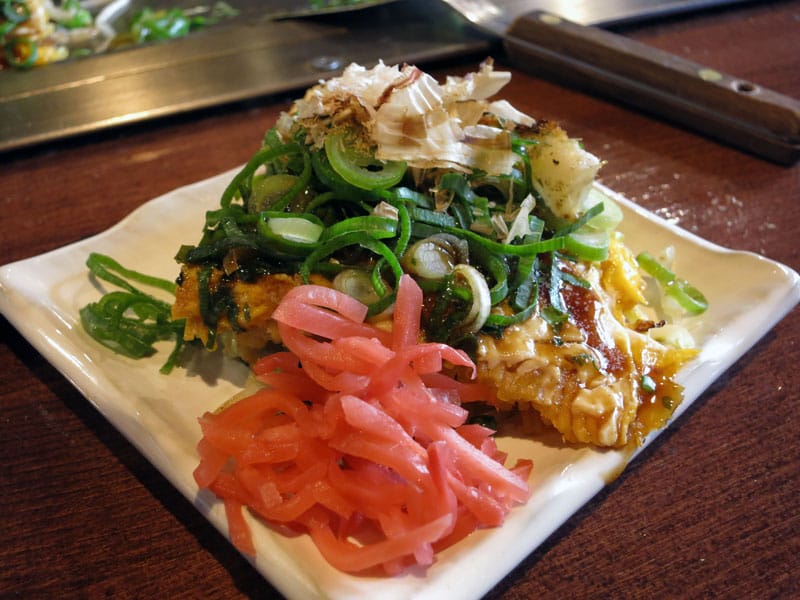
The place to sit is along the small counter fronting the teppan, which Fuku-san likes to boast costs in the $10,000 range and is almost two inches thick. On our last visit we chose the shrimp okonomiyaki and counted at least 15 steps in its preparation. First came batter on the grill, seasoned with some special spices. Next, a rain of ingredients as the batter started to form a small crepe-like base: chunky cabbage, gleaming bean sprouts, sliced scallions, pepper, popped Japanese rice and succulent slices of raw pork belly, all slicked over with oil and then flipped so the pancake sat atop the ingredients.
We sat drinking beer until it was time for the chef to oil the teppan and slam a tangle of noodles onto it. This was the beginning of the layering process that produces the Hiroshima okonomiyaki. The noodles were heaped on the mound and left to meld.
Succulent shrimp spiked with cayenne and pepper was calmly grilling nearby. Meanwhile, Fuku-san lightly fried an egg, its yolk still runny, then added it to the top. Another pancake went atop the tower, and by some kind of magic, he flipped the whole construction to continue grilling. Then came a secret sauce lathered over the finished pancake, with the shrimp nestled into the glaze.
After scattering scallions over the top, Fuku-san slid the result to the side of the teppan in front of our seats for presentation. We used a small trowel accompanying the pancake to section it and place a wedge on our plate, then scooped pickled ginger and bonito to our heart’s content from pots conveniently located along the counter. Next came a decorating frenzy using a squeeze bottle containing Japanese mayo and another with otafuku sauce. Finally, bedazzled by the many aromas of the contents, we scooped up hunks of the pancake using chopsticks.

Jyaken Nou also serves Hiroshima-style dandan noodles. These noodles, Chinese in origin, are usually served with a hot, spicy sauce. The version here is a generous bowl with pork, egg, spring onion, bean sprouts and a heaping of gorgeous Hiroshima oysters floating in it.
The restaurant tends to be seriously crowded at meal times, as locals and Hiroshima natives line up for their favorite soul food. At off-peak hours it’s usually possible to snag a seat at one of the few tables on the side and in the back, but the best spot, of course, is at the counter, where the magic happens.
Published on February 07, 2017
Related stories
May 3, 2016
AthensThe oldest taverna in central Athens features delicious and simple food all prepared by Mr Dimitris, who has been running it since he was a child! This is a place one may stumble into on our Downtown Athens walk.
July 7, 2022
PortoMore than a food staple, the rissol is also a symbol of the popular culture in Portugal, where locals eat it standing at counters, always paired with a cup of coffee – or a glass of tap beer from eleven o'clock onwards. Rissóis (plural) are half-moon-shaped savory pastries of peasant origins, and from grandmothers' houses…
November 20, 2023
IstanbulTucked away on the fourth floor of a nondescript building in the heart of Istanbul's Beyoğlu districts lies a hidden gem that we just discovered, despite the fact that Antakya Mutfağı has been in business for twenty years. Here, the Kar family serves up the cuisine of the southern province of Hatay, which boasts some…







































